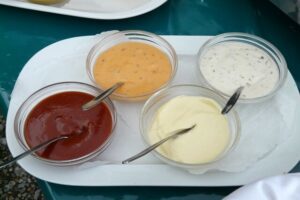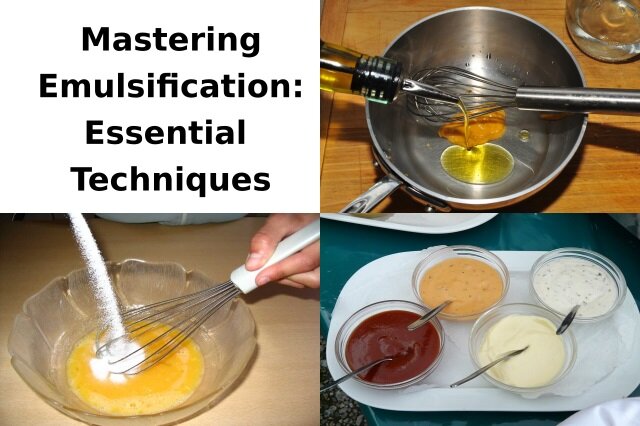Mastering Emulsification:
Essential Techniques for Chefs and Home Cooks Alike
 Mastering the art of emulsification is a game-changer for chefs and home cooks alike.
Mastering the art of emulsification is a game-changer for chefs and home cooks alike.
It’s the secret behind creating velvety smooth sauces, creamy dressings, and perfectly emulsified vinaigrettes.
But what exactly is emulsification, and how can you master this essential culinary technique?
Emulsification is the process of combining two liquids that don’t typically mix, like oil and vinegar, into a stable and smooth mixture.
It’s all about creating tiny droplets of one liquid dispersed throughout the other, resulting in a homogenous and well-balanced emulsion.
In this article, we’ll explore the essential techniques for achieving emulsification perfection. From understanding the science behind emulsification to learning the proper whisking and blending techniques, you’ll discover the tips and tricks that professional chefs use to create flawless emulsions every time.
Whether you’re a seasoned chef or a passionate home cook, mastering emulsification will elevate your culinary creations to new heights. Get ready to unlock the secrets of emulsification and take your dishes from ordinary to extraordinary.
What is emulsification in cooking?
Emulsification is a fundamental technique in cooking that allows you to create stable mixtures of two liquids that would otherwise separate. The key to successful emulsification lies in the ability to suspend one liquid, known as the dispersed phase, within the other liquid, known as the continuous phase. This creates a uniform mixture with a smooth texture and consistent flavour.
To achieve emulsification, you need an emulsifying agent, which acts as a bridge between the two liquids.
Common emulsifying agents include egg yolks, mustard, and lecithin.
These substances contain molecules that have both hydrophilic (water-loving) and lipophilic (fat-loving) properties, allowing them to bind with both water and fat molecules.
The science behind emulsification
Emulsification is a result of the physical properties of water and oil.
Water is a polar molecule, meaning it has a positive and negative end, while oil is nonpolar.
These differences in polarity make it difficult for water and oil to mix together.
However, when an emulsifying agent is added, it provides stability to the mixture by forming a protective layer around the oil droplets, preventing them from coalescing and separating.
The emulsifying agent works by reducing the surface tension between water and oil, allowing them to mix more easily.
This is achieved through a process called micelle formation, where the emulsifying agent surrounds the oil droplets and keeps them dispersed throughout the water.
The result is a stable emulsion that remains blended for an extended period.
Importance of emulsification in culinary techniques
Emulsification plays a crucial role in the culinary world, as it allows chefs and home cooks to create a wide range of sauces, dressings, and other culinary delights.
Without emulsification, ingredients like oil and vinegar would quickly separate, resulting in an unappetising and visually unappealing dish.
Emulsification also enhances the texture and mouthfeel of dishes.
By creating a smooth and creamy emulsion, you can add a luxurious and velvety texture to your sauces and dressings.
This can elevate even the simplest of dishes, turning them into culinary masterpieces.
Basic emulsification techniques – oil and vinegar, mayonnaise, and vinaigrettes
One of the most common and straightforward emulsification techniques is combining oil and vinegar.
This is the foundation for many classic salad dressings and vinaigrettes.
- Oil and vinegar;
- The key to a successful oil and vinegar emulsion is slowly adding the oil to the vinegar while whisking vigorously.
This allows the oil droplets to disperse evenly throughout the vinegar, creating a smooth and stable mixture. - Mayonnaise;
- Another popular emulsification technique is making mayonnaise.
Mayonnaise is a thick and creamy emulsion of egg yolks, oil, vinegar or lemon juice, and seasonings.The process involves slowly incorporating the oil into the egg yolks while whisking continuously.
With patience and practice, you can achieve a rich and luscious mayonnaise that can elevate any sandwich or salad. - Vinaigrettes;
Vinaigrettes are another versatile emulsion that can be customised with various ingredients and flavours.
By combining oil, vinegar, and other desired ingredients like mustard, honey, or herbs, you can create a tangy and well-balanced dressing.
The key to a successful vinaigrette is whisking the ingredients together until they emulsify into a smooth and homogeneous mixture.
Advanced emulsification techniques – hollandaise sauce, aioli, and beurre blanc
Moving beyond the basics, there are several advanced emulsification techniques that can take your culinary creations to the next level.
- Hollandaise sauce;
- One such technique is making hollandaise sauce, a classic French sauce known for its rich and buttery flavour.
Hollandaise sauce is made by emulsifying melted butter into egg yolks and lemon juice.
The process requires careful whisking and temperature control to achieve a smooth and silky sauce. - Aioli;
- Aioli is another popular emulsion that adds a bold and garlicky flavour to dishes.
This Mediterranean sauce is made by emulsifying garlic, olive oil, and egg yolks.
The key to a successful aioli is slowly incorporating the oil into the garlic and egg yolks while whisking vigorously.
With the right technique, you can achieve a creamy and flavourful aioli that pairs well with seafood, vegetables, and more. - Beurre blanc;
Beurre blanc, or white butter sauce, is a classic French emulsion that adds richness and depth to dishes.
This sauce is made by emulsifying butter into a reduction of white wine, vinegar, and shallots.
The process involves gradually adding cold butter to the reduction while whisking continuously.
The result is a smooth and velvety sauce that pairs perfectly with fish, poultry, and vegetables.
Troubleshooting common emulsification problems
While emulsification can be a straightforward process, it’s not without its challenges.
Common problems include the emulsion breaking or separating, resulting in a greasy or watery texture.
Fortunately, there are several troubleshooting techniques to help you salvage a broken emulsion.
One common issue is adding the oil too quickly. To prevent this, it’s essential to add the oil gradually, allowing it to incorporate fully before adding more.
Another potential problem is using ingredients that are too cold or too warm.
Ensuring that all ingredients are at a similar temperature can help promote a stable emulsion.
If your emulsion does break, you can often fix it by adding a small amount of water or an emulsifying agent, like mustard or egg yolk.
Whisking vigorously can also help re-emulsify the mixture.
With practice and understanding, you’ll become adept at troubleshooting emulsification problems and achieving consistent results.
Sometimes, despite your best efforts, an emulsion sauce might still break on you.
If this happens, you may be able to rescue it.
See the troubleshooting guide below for some quick fixes.
| Sauce | Problem | Cause | Fix |
|---|---|---|---|
| Hollandaise | Splits | Too much heat, not whisking constantly, or adding too much cold liquid | Start over with a clean pan and whisk constantly over low heat. Add the liquid slowly, one drop at a time. |
| Mayonnaise | Won’t thicken | Not enough egg yolks, not whisking constantly, or adding too much oil | Add an extra egg yolk and whisk constantly until the sauce thickens. |
| Vinaigrette | Separates | Not whisking constantly, or adding too much oil | Whisk constantly while adding the oil in a slow, steady stream. |
| Aioli | Won’t emulsify | Not enough garlic, not whisking constantly, or adding too much oil | Add more garlic and whisk constantly until the sauce emulsifies. |
Tools and equipment for successful emulsification
Having the right tools and equipment can make a significant difference in your emulsification success.
- A whisk is a versatile tool that is essential for creating emulsions.
Choose a whisk with thin wires that allow for efficient blending and incorporate air into the mixture. - A blender or immersion blender can also be useful for emulsifying ingredients quickly and effortlessly.
- In addition to tools, choosing the right ingredients is crucial for successful emulsification.
Look for high-quality oils, vinegars, and emulsifying agents.Using fresh ingredients and incorporating them at the appropriate temperature will help ensure a stable and flavorful emulsion.
Tips and tricks for mastering emulsification
Mastering emulsification requires practice and attention to detail.
Here are some tips and tricks to help you become a pro at creating perfect emulsions:
- Start with room temperature ingredients to promote better emulsion formation.
- Add the oil or fat slowly and gradually, allowing it to incorporate fully before adding more.
- Whisk or blend vigorously to encourage the formation of a stable emulsion.
- Use an emulsifying agent, like mustard or egg yolk, to enhance stability and texture.
- Adjust the seasoning and acidity to achieve a well-balanced flavour profile.
- Experiment with different oils, vinegars, and emulsifying agents to create unique and flavorful emulsions.
By incorporating these tips and tricks into your cooking routine, you’ll be well on your way to mastering the art of emulsification.
Recipes showcasing different emulsification techniques
To put your newfound emulsification skills to the test, here are a few recipes that highlight different emulsification techniques:
- Classic Caesar Salad Dressing:
- This Caesar Salad recipe combines emulsification techniques to create a creamy and tangy dressing that perfectly complements crisp romaine lettuce and crunchy croutons.
- Eggs benedict:
- When making Eggs Benedict, the hollandaise sauce is made by whisking together egg yolks, butter, and lemon juice.
The whisking motion helps to create tiny droplets of butter that are suspended in the egg yolks.
The lecithin in the egg yolks helps to keep these droplets from separating. - Cocktail sauce:
- This is a smooth and creamy, slightly tangy cocktail sauce using emulsification.
It’s the perfect accompaniment for seafood, chicken plus other appetisers and finger foods. - Lemon Butter Sauce:
- This versatile sauce showcases the art of emulsification, combining butter, lemon juice, and herbs to create a luscious and flavourful sauce that pairs well with fish, chicken, or vegetables.
- Basil Aioli:
- Elevate your sandwich or burger with this vibrant and garlicky aioli.
The emulsification of fresh basil, garlic, olive oil, and egg yolks creates a creamy and aromatic condiment that will take your meal to the next level. - Balsamic Vinaigrette:
- This simple yet flavourful vinaigrette combines the emulsification of balsamic vinegar, olive oil, Dijon mustard, and honey to create a well-balanced dressing that can be used on salads, roasted vegetables, and more.
Feel free to experiment with these recipes and adjust the flavors and ingredients to suit your taste preferences.
Conclusion and final thoughts on mastering emulsification
Mastering emulsification is a skill that can elevate your culinary creations and impress even the most discerning palate.
By understanding the science behind emulsification, learning the proper techniques, and practicing with different recipes, you’ll soon become a pro at creating velvety smooth sauces, creamy dressings, and perfectly emulsified vinaigrettes.
Remember, emulsification is an art form that requires attention to detail and patience.
Don’t be discouraged by a few failed attempts or minor setbacks.
With practice and perseverance, you’ll develop the skills and intuition needed to create flawless emulsions every time.
So, whether you’re a seasoned chef or a passionate home cook, embrace the world of emulsification and unlock the secrets that will take your dishes from ordinary to extraordinary.
Embrace the possibilities and let your creativity shine as you master the art of emulsification.
Happy cooking!
